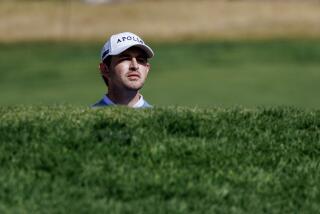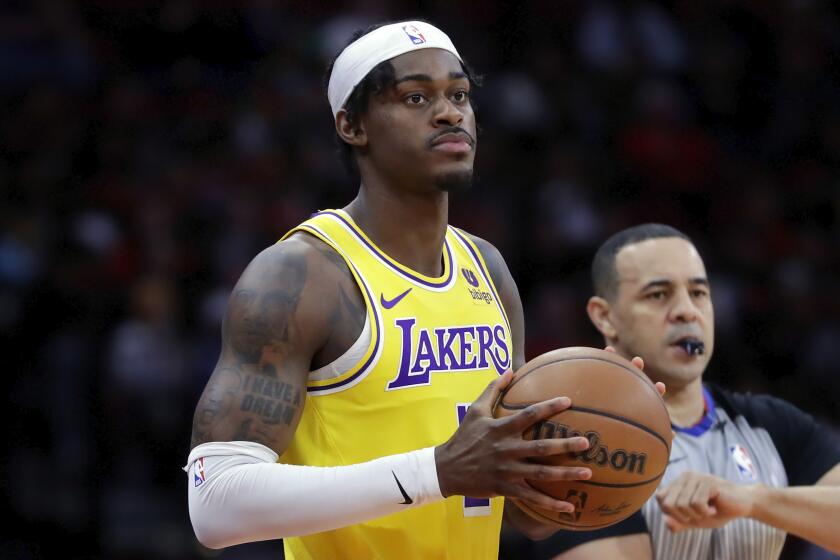Woosnam, Knox Beat the Stick : Golf: They are the early first-round leaders at five-under-par 67.
- Share via
CARMEL, Ind. — The game went on, despite the second tragic lightning-caused death of a spectator in one of golf’s major championships.
Ian Woosnam and Kenny Knox slipped into a tie for the first-round lead in the PGA on Thursday before a thunderstorm ripped the Crooked Stick course and, in an eerie replay of the tragedy during the U.S. Open at Hazeltine, claimed the life of a spectator.
Woosnam welcomed the heavy rains that accompanied the violent storm, but the short-hitting Knox did not.
“I like it a bit wet,” Woosnam said after a five-under-par 67 on a very long but, at that time, relatively dry course.
“I don’t need rain,” Knox said. “You’ve got some long-ball hitters out there who are going to play good and if it rains, there’s par-fours I can’t get to.”
It didn’t just rain. It rained hard, a third of an inch in just 30 minutes.
More rain was forecast today, threatening a disruption of the last of the year’s Big Four golf events and playing into the hands of the game’s longer hitters.
The Pete Dye-designed course, listed at 7,289 yards, was set up Thursday at 7,281, the longest ever for a major championship. With the rain, it will play even longer.
“When somebody yells ‘Hey, One-Putt,’ I look up,” Knox said. “I’m a great chipper and putter. I can chip and putt with anybody in the world, but I’m not long.”
Woosnam is. Despite his 5-foot-4 1/2 stature, the Masters champion is one of the longer hitters in golf. So are Sandy Lyle, Bruce Lietzke, Craig Stadler and Tom Purtzer, and all were among the early leaders.
Lyle, a former Masters and British Open champion from Scotland, Lietzke and Stadler were tied with Ken Green at 68.
Purtzer was with Jim Hallet and Billy Ray Brown at 69.
Woosnam and Knox played before the course grew teeth in the rain and found it at its most forgiving.
“Definitely two shots easier than yesterday” in practice rounds, Woosnam said. “Some of the tees were up and that made it just that much easier.”
He missed only one green on the front, played that side in 35, and then found his putting touch on the back.
He birdied the 11th hole from eight feet, the 13th from 20, the 14th from 15 and 16th from about the same range.
Two critical saves from bunkers, on the 15th and 17th, got him in with a share of the lead.
Woosnam played in a threesome with the other holders of major 1991 titles, U.S. Open champ Payne Stewart and British Open winner Ian Baker-Finch of Australia. Each shot 74.
Knox, winner of three titles in a 10-year career on the American tour, centered his effort on a pair of pitch-in eagles and his usual putting heroics.
He holed a 45-yard sand wedge for an eagle-3 on the ninth to get back to even par for the day, then watched a 168-yard five-iron shot “trickle in the hole like a putt” for eagle-2 on the 12th.
Knox also one-putted the last four holes, three for birdies, and needed only 10 putts over the last 10 holes.
“My chances of winning are pretty shaky,” he said. “I’d love to stay in the red numbers, but the guys out there are not worried about Kenny Knox.”
Steve Pate played in a threesome with Tim Simpson and Tom Kite, the men most closely involved in the chase for the final spot on the American Ryder Cup team.
Coming into this event, the last qualifying tournament for places on that team, Simpson was 10th, Pate 11th and Kite 12th on the list from which 10 players will be chosen. Pate shot 70, Kite shot 73 and Simpson 74.
Curtis Strange put a pair of front-side 7s on his card, struggled to an 81 and withdrew.
Last year at Shoal Creek, Green saw his tee time printed in a newspaper as Eastern Daylight Time and didn’t realize the tournament was being held in a different time zone.
“I arrived at 8:15 for what I thought was an 8:40 tee time. It was really a 7:40 tee time. I forgot Birmingham (Ala.) was on Central time,” he said.
Green was out of the tournament before he had the chance to lift a club.
“This year,” he said, “I was a little more intelligent and actually verified my tee time.”
It’s his first good luck in a year that has seen Green miss seven cuts and withdraw from the U.S. Open after a first-round 81.
More to Read
Go beyond the scoreboard
Get the latest on L.A.'s teams in the daily Sports Report newsletter.
You may occasionally receive promotional content from the Los Angeles Times.










